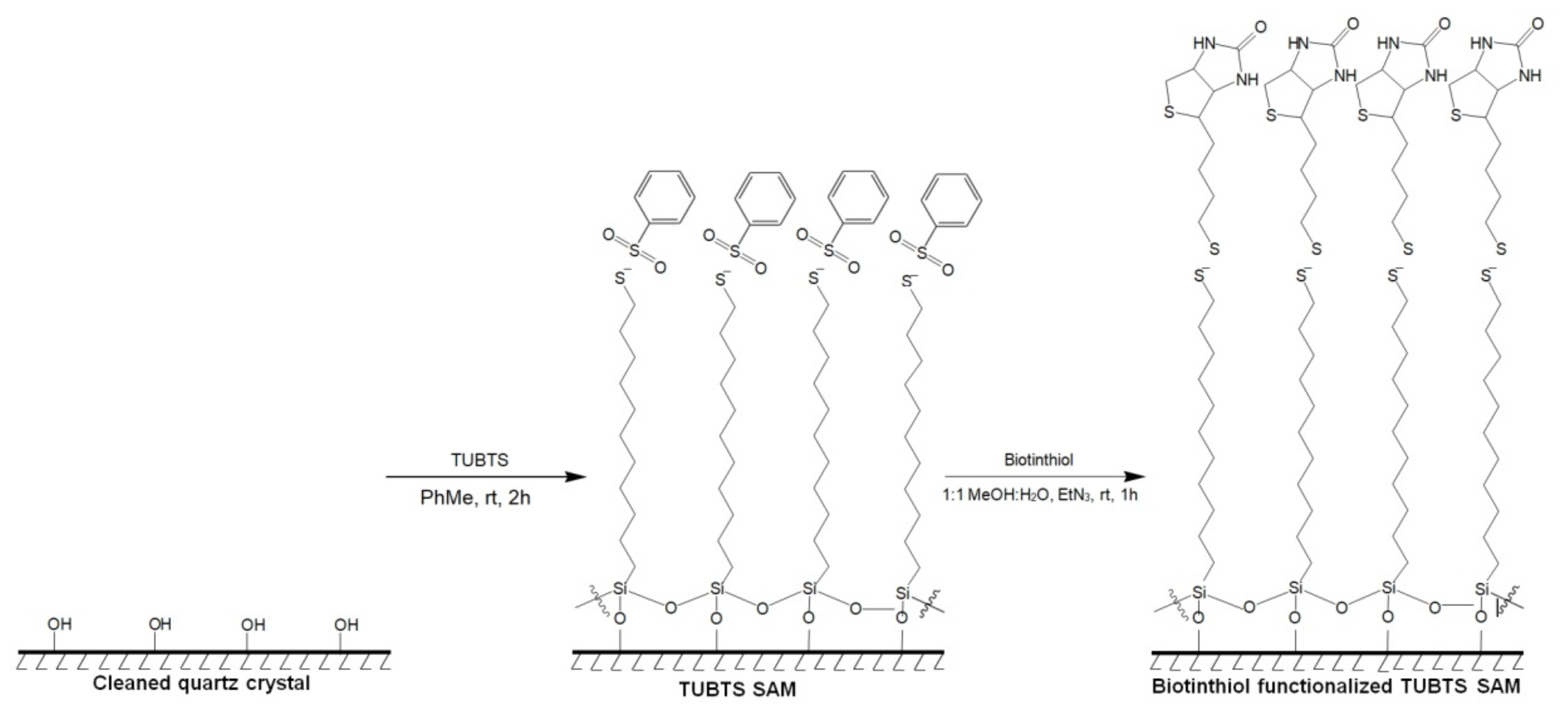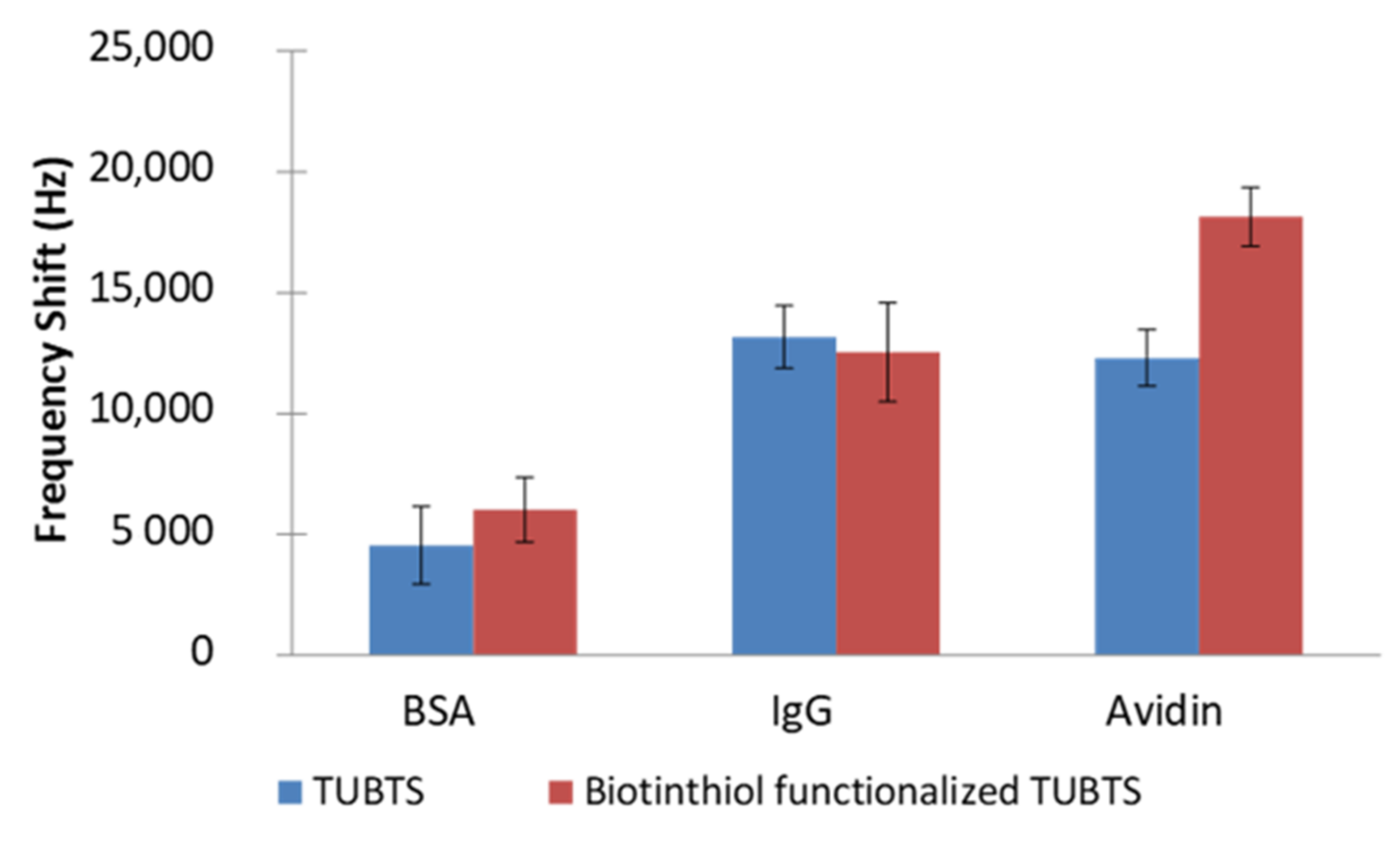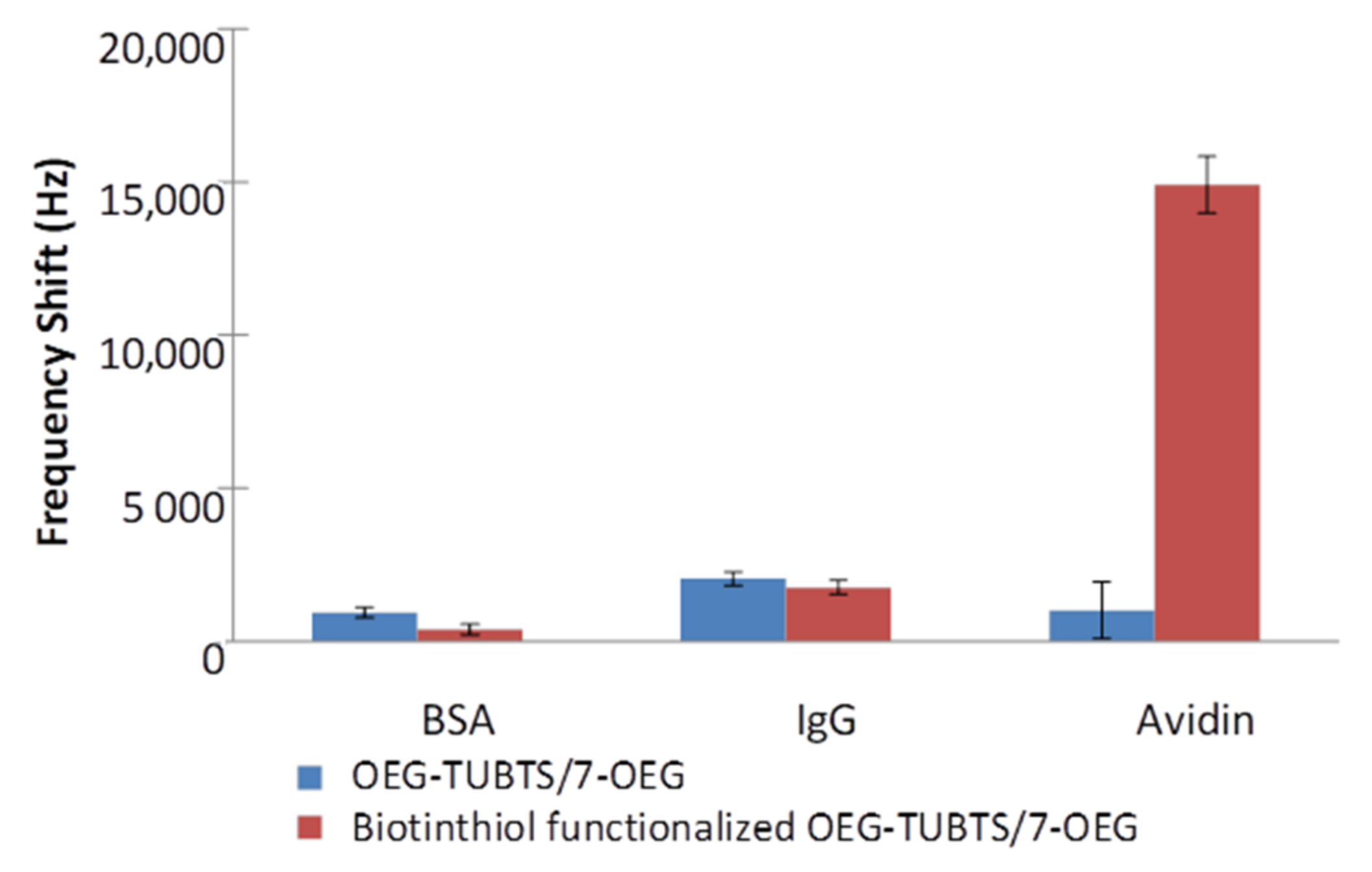Assembling Surface Linker Chemistry with Minimization of Non-Specific Adsorption on Biosensor Materials
Abstract
:1. Introduction
2. Materials and Methods
2.1. Materials and Surface-Modifying Molecules
2.2. Substrate Preparation
2.3. Silanization Procedure
2.4. Attachment of Biotinthiol
2.5. Cleavage of the Diluent TFA Head Group
2.6. Surface Characterization
2.7. EMPAS Measurements
3. Results and Discussion
3.1. Surface Characterization
3.1.1. Contact Angle Measurement
3.1.2. XPS Analysis
3.2. EMPAS Detection of Surface Interactions
3.2.1. TUBTS SAMs
3.2.2. Potential SAM Diluents
3.2.3. Mixed SAMs
4. Final Remarks
Supplementary Materials
Author Contributions
Funding
Institutional Review Board Statement
Informed Consent Statement
Data Availability Statement
Acknowledgments
Conflicts of Interest
References
- Pingarron, J.M.; Luong, J.H. (Eds.) Biosensor. In Technology: Fundamentals, Applications, and New Challenges, 1st ed.; CRC Press: Boca Raton, FL, USA, 2016. [Google Scholar]
- Wong, E.L.S.; Gooding, J.J. Charge transfer through DNA: A selective electrochemical DNA biosensor. Anal. Chem. 2006, 78, 2138–2144. [Google Scholar] [CrossRef]
- Cooper, M. Optical biosensors in drug discovery. Nat. Rev. Drug. Discov. 2002, 1, 515–528. [Google Scholar] [CrossRef]
- Maraldo, D.; Mutharasan, R. Optimization of antibody immobilization for sensing using piezoelectrically excited-millimeter-sized cantilever (PEMC) sensors. Sens. Actuators B 2007, 123, 474–479. [Google Scholar] [CrossRef]
- Sassolas, A.; Akhtar Hayat, A.; Jean-Louis Marty, J.-L. Enzyme immobilization by entrapment within a gel network. Methods Mol. Biol. 2013, 1051, 229–239. [Google Scholar]
- Haupt, K.; Mosbach, K. Molecularly imprinted polymers and their use in biomimetic sensors. Chem. Rev. 2000, 100, 2495–2504. [Google Scholar] [CrossRef]
- Blodgett, K.B. Films built by depositing successive monomolecular layers on a solid surface. J. Am. Chem. Soc. 1935, 57, 1007–1022. [Google Scholar] [CrossRef]
- Ohnuki, H.; Honjo, R.; Edno, H.; Imakubo, T.; Izumi, M. Amperometric cholesterol biosensors based on hybrid organic–inorganic Langmuir–Blodgett films. Thin Solid Films 2009, 518, 596–599. [Google Scholar] [CrossRef]
- Wink, T.; van Zuilen, S.J.; Bult, A.; van Bennkom, W.P. Self-assembled monolayers for biosensors. Analyst 1997, 122, 43R–50R. [Google Scholar] [CrossRef]
- Cancino, J.; Razzino, C.A.; Zucolotto, V.; MacHado, S.A.S. The use of mixed self-assembled monolayers as a strategy to improve the efficiency of carbamate detection in environmental monitoring. Electrochim. Acta 2013, 87, 713–723. [Google Scholar] [CrossRef]
- Thompson, M.; Sheikh, S.; Blaszykowski, C.; de los Santos Pereira, A.; Rodriguez-Emmenegger, C. Biological Fluid Surface Interactions in Detection and Medical Devices; Royal Society of Chemistry: Cambridge, UK, 2016. [Google Scholar]
- Banerjee, I.; Pangule, R.C.; Kane, R.S. Antifouling coatings: Recent Developments in the Design of Surfaces that Prevent Fouling by Proteins, Bacteria, and Marine Organisms. Adv. Mater. 2011, 23, 690–718. [Google Scholar] [CrossRef]
- Blaszykowski, C.; Sheikh, S.; Thompson, M. Surface chemistry to minimize fouling from blood-based fluids. Chem. Soc. Rev. 2012, 41, 5599–5612. [Google Scholar] [CrossRef] [PubMed]
- Damodaran, V.B.; Murthy, N.S. Bio-inspired strategies for designing antifouling biomaterials. Biomater. Res. 2016, 20, 18. [Google Scholar] [CrossRef] [PubMed] [Green Version]
- Blaszykowski, C.; Sheikh, S.; Thompson, M. A Survey of state-of-the-art surface chemistries to minimize fouling from human and animal biofluids. Biomater. Sci. 2015, 3, 1335–1370. [Google Scholar] [CrossRef] [PubMed]
- Ulman, A. Formation and structure of self-assembled monolayers. Chem. Rev. 1996, 96, 1533–1554. [Google Scholar] [CrossRef] [PubMed]
- Spura, A.; Riel, R.U.; Freedman, N.D.; Agrawal, S.; Seto, C.; Hawrot, E. Biotinylation of substituted cysteines in the nicotinic acetylcholine receptor reveals distinct binding modes for alpha-bungarotoxin and erabutoxin a. J. Biol. Chem. 2000, 275, 22452–22460. [Google Scholar] [CrossRef] [PubMed] [Green Version]
- Parikh, A.N.; Schivley, M.A.; Koo, E.; Seshadri, K.; Aurentz, D.; Mueller, K.; Allara, D.L. n-Alkylsiloxanes: from single monolayers to layered crystals. The formation of crystalline polymers from the hydrolysis of n-octadecyltrichlorosilane. J. Am. Chem. Soc. 1997, 119, 3135–3143. [Google Scholar] [CrossRef]
- Nuzzo, R.G.; Dubois, L.H.; Allara, D.L. Spontaneously organized molecular assemblies. 3. Preparation and properties of solution adsorbed monolayers of organic disulfides on gold surfaces. J. Am. Chem. Soc. 1990, 112, 558–569. [Google Scholar] [CrossRef]
- Prime, K.L.; Whitesides, G.M. Adsorption of proteins onto surfaces containing end-attached oligo(ethylene oxide): A model system using self-assembled monolayers. J. Am. Chem. Soc. 1993, 115, 10714–10721. [Google Scholar] [CrossRef]
- Chapman, R.G.; Ostuni, E.; Liang, M.N.; Meluleni, G.; Kim, E.; Yan, L.; Pier, G.; Warren, H.S.; Whitesides, G.M. Polymeric thin films that resist the adsorption of proteins and the adhesion of bacteria. Langmuir 2001, 17, 1225–1233. [Google Scholar] [CrossRef]
- Xia, N.; Hu, Y.; Grainger, D.W.; Castner, D.G. Functionalized poly(ethylene glycol)-grafted polysiloxane monolayers for control of protein binding. Langmuir 2002, 18, 3255–3262. [Google Scholar] [CrossRef]
- Hayashi, T.; Tanaka, Y.; Koide, Y.; Tanaka, M.; Hara, M. Mechanism underlying bioinertness of self-assembled monolayers of oligo(ethylene glycol)-terminated alkanethiols on gold: Protein adsorption, platelet adhesion, and surface forces. Phys. Chem. Chem. Phys. 2012, 14, 10196–10206. [Google Scholar] [CrossRef]
- McPherson, T.; Kidane, A.; Szleifer, I.; Park, K. Prevention of protein adsorption by tethered poly(ethylene oxide) layers: Experiments and single-chain mean-field analysis. Langmuir 1998, 14, 176–186. [Google Scholar] [CrossRef]
- Zheng, J.; Li, L.; Chen, S.; Jiang, S. Molecular simulation study of water interactions with oligo (ethylene glycol)-terminated alkanethiol self-assembled monolayers. Langmuir 2004, 20, 8931–8938. [Google Scholar] [CrossRef]
- Pertsin, A.J.; Grunze, M. Computer simulation of water near the surface of oligo(ethylene glycol)-terminated alkanethiol self-assembled monolayers. Langmuir 2000, 16, 8829–8841. [Google Scholar] [CrossRef]
- Archambault, J.G.; Brash, B.L. Protein repellent polyurethane-urea surfaces by chemical grafting of hydroxyl-terminated poly(ethylene oxide): Effects of protein size and charge. Colloids Surf. B Biointerfaces 2004, 33, 111–120. [Google Scholar] [CrossRef]
- Zheng, J.; Li, L.; Tsao, H.K.; Sheng, Y.J.; Chen, S.; Jiang, S. Strong repulsive forces between protein and oligo (ethylene glycol) self-assembled monolayers: A molecular simulation study. Biophys. J. 2005, 89, 158–166. [Google Scholar] [CrossRef] [Green Version]
- Sheikh, S.; Yang, D.Y.; Blaszykowski, C.; Thompson, M. Single ether group in glycol-based ultra-thin layer monolayer prevents surface fouling from undiluted serum. Chem. Comms. 2012, 48, 1305–1307. [Google Scholar] [CrossRef]
- Fedorov, K.; Blaszykowski, C.; Sheikh, S.; Reheman, A.; Romaschin, A.; Ni, H.; Thompson, M. Prevention of thrombogenesis from whole human blood on plastic polymer by ultrathin monoethylene glycol silane adlayer. Langmuir 2014, 30, 3217–3222. [Google Scholar] [CrossRef]
- Fedorov, K.; Jankowski, A.; Sheikh, S.; Blaszykowski, C.; Reheman, A.; Romaschin, A.; Ni, H.; Thompson, M. Prevention of surface-induced thrombogenesis on poly(vinyl chloride). J. Mater. Chem. B 2015, 3, 8623–8628. [Google Scholar] [CrossRef]
- Fedorov, K.; Sheikh, S.; Romaschin, A.; Thompson, M. Enhanced long-term antithrombogenicity instigated by a covalently-attached surface modifier on biomedical polymers. Res. Prog. Mater. Spec. Issue Appl. Dev. Biomater. Med. 2020, 2. [Google Scholar] [CrossRef]
- Briand, E.; Salmain, M.; Herry, J.-M.; Perrot, H.; Compère, C.; Pradier, C.-M. Building of an immunosensor: How can the composition and structure of the thiol attachment layer affect the immunosensor efficiency? Biosens. Bioelectron. 2006, 22, 440–448. [Google Scholar] [CrossRef] [PubMed] [Green Version]
- Sheikh, S.; Sheng, J.C.; Blaszykowski, C.; Thompson, M. New oligoethylene glycol linkers for the surface modification of an ultra-high frequency acoustic wave biosensor. Chem. Sci. 2010, 1, 271–275. [Google Scholar] [CrossRef]
- Ballantyne, S.M.; Thompson, M. Superior analytical sensitivity of electromagnetic excitation compared to contact electrode instigation of transverse acoustic waves. Analyst 2004, 129, 219–224. [Google Scholar] [CrossRef] [PubMed]
- Chan, E.; Jackson, N.; Mathewson, G.A.P.; Blaszykowski, C.; Alamin Dow, A.P.; Kherani, N.P.; Thompson, M. Surface modification of aluminum nitride with functionalizable organosilane adlayers for ultra-high frequency acoustic wave seniors. Appl. Surf. Sci. 2013, 282, 707–713. [Google Scholar] [CrossRef]
- Albrecht, T.R.; Akamine, S.; Carver, T.E.; Quate, C.F. Microfabrication of cantilever styli for the atomic force microscope. J. Vac. Sci. Technol. A Vac. Surf. Films 1990, 8, 3386–3396. [Google Scholar] [CrossRef]
- Pawlowska, N.M.; Fritzsche, H.; Vezvaiem, M.; Blaszykowski, C.S.; Sheikh, S.; Thompson, M. Probing the hydration of ultra-thin antifouling silane adlayers using neutron reflectometry. Langmuir 2014, 30, 1199–1203. [Google Scholar] [CrossRef]
- Sheikh, S.; Blaszykowski, C.; Thompson, D.; Thompson, M. On the hydration of subnanometric antifouling organosilane adlayers: A molecular dynamics simulation. J. Colloid Interface Sci. 2015, 437, 197–204. [Google Scholar] [CrossRef]
- Kane, R.S.; Deschatelets, P.; Whitesides, G.M. Kosmotropes form the basis of protein-resistant surfaces. Langmuir 2003, 19, 2388–2391. [Google Scholar] [CrossRef]










| Surface | Value |
|---|---|
| Quartz | 12° ± 2° |
| TUBTS | 6° ± 3° |
| TUBTS–Biotin | 78° ± 3° |
| OEG–TUBTS | 72° ± 4° |
| OEG-TUBTS-Biotin | 64° ± 3° |
| 10–OEG–TFA | 70° ± 2° |
| 10–OEG | 25° ± 4° |
| 7–OEG–TFA | 66° ± 2° |
| 7–OEG | 20° ± 5° |
| 13–OEG–TFA | 77° ± 3° |
| 13–OEG | 24° ± 3° |
| OEG–TUBTS/7–OEG–TFA | 64° ± 4° |
| OEG–TUBTS/7–OEG–Biotin | 55° ± 6° |
| - | |
| Si3N4 | 5° ± 2° |
| Si3N4/TUBTS | 71° ± 3° |
| Si3N4/TUBTS–Biotin | 63° ± 3° |
| - | |
| AlN | 4° ± 2° |
| AlN/TUBTS | 81° ± 1° |
| AlN/TUBTS–Biotin | 69° ± 4° |
| Surface | Si (2p) | O (1s) | C (1s) | S (2p) | N (1s) | F (1s) |
|---|---|---|---|---|---|---|
| Quartz | 40.3 | 52.8 | 6.9 | 0.0 | ||
| TUBTS | 3.0 | 0.0 | ||||
| TUBTS-Biotin | 5.6 | 5.3 | ||||
| OEG–TUBTS | 12.8 | 28.4 | 56.0 | 2.8 | 0.0 | |
| OEG–TUBTS–Biotin | 5.5 | 24.8 | 61.9 | 4.6 | 3.1 | |
| 10–OEG–TFA | 37.5 | 38.6 | 20.2 | 3.8 | ||
| 10–OEG | 30.9 | 41.8 | 27.5 | 0.0 | ||
| 7–OEG–TFA | 31.9 | 53.8 | 10.0 | 4.3 | ||
| 7–OEG | 34.2 | 53.2 | 12.0 | 0.0 | ||
| 13–OEG–TFA | 24.1 | 39.0 | 39.2 | 1.7 | ||
| 13–OEG | 26.3 | 34.7 | 39.1 | 0.0 | ||
| OEG–TUBTS/7–OEG–TFA | 18.0 | 48.0 | 30.3 | 1.7 | 0.0 | 2.0 |
| OEG–TUBTS/7–OEG–Biotin | 22.7 | 36.5 | 35.8 | 2.5 | 2.5 | 0.0 |
| - | ||||||
| Si3N4/TUBTS | 27.9 | 19.0 | 44.0 | 1.6 | 6.9 | |
| Si3N4/TUBTS–Biotin | 16.1 | 21.8 | 43.6 | 5.5 | 2.6 | |
| - | ||||||
| AlN/TUBTS | 1.1 | 28.8 | 23.0 | 2.3 | 10.0 | |
| AlN/TUBTS–Biotin | 9.7 | 21.9 | 41.8 | 5.2 | 3.7 |
Publisher’s Note: MDPI stays neutral with regard to jurisdictional claims in published maps and institutional affiliations. |
© 2021 by the authors. Licensee MDPI, Basel, Switzerland. This article is an open access article distributed under the terms and conditions of the Creative Commons Attribution (CC BY) license (http://creativecommons.org/licenses/by/4.0/).
Share and Cite
Sheng, J.C.-C.; De La Franier, B.; Thompson, M. Assembling Surface Linker Chemistry with Minimization of Non-Specific Adsorption on Biosensor Materials. Materials 2021, 14, 472. https://doi.org/10.3390/ma14020472
Sheng JC-C, De La Franier B, Thompson M. Assembling Surface Linker Chemistry with Minimization of Non-Specific Adsorption on Biosensor Materials. Materials. 2021; 14(2):472. https://doi.org/10.3390/ma14020472
Chicago/Turabian StyleSheng, Jack Chih-Chieh, Brian De La Franier, and Michael Thompson. 2021. "Assembling Surface Linker Chemistry with Minimization of Non-Specific Adsorption on Biosensor Materials" Materials 14, no. 2: 472. https://doi.org/10.3390/ma14020472
APA StyleSheng, J. C. -C., De La Franier, B., & Thompson, M. (2021). Assembling Surface Linker Chemistry with Minimization of Non-Specific Adsorption on Biosensor Materials. Materials, 14(2), 472. https://doi.org/10.3390/ma14020472






